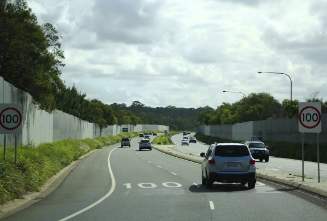DKT Test (Speed Limits) #1
This sign indicates that you must:

Explanation:
This road will be shared by walkers and other vehicles. The speed restriction is ten kilometers per hour.
In a 60 km/h zone, you're stuck in heavy traffic. 60 km/h seems a little fast given the conditions. So, what are your options?
Explanation:
You have control over your speed. Slow down if you don't feel comfortable going at a specific speed.
The speed restriction is 100 km/h where there are no speed limit signs, unless:
The correct answer:
There are street lights along the road.
It is illegal to have a radar detector or jammer in your car:
Explanation:
In your car, you are not permitted to use a radar detector or a jammer.
What are the possible consequences of exceeding the speed limit?
Explanation:
For exceeding the speed limit, you could face a hefty fine, the loss of your license, and the accumulation of demerit points.
The speed limit in a Shared Traffic Zone, where walkers and other road users can safely share the road, is:
Explanation:
Pedestrians and automobiles will share the route, the speed limit is set at 10 km/h.
It's illegal to drive faster than the posted speed limit because:
Explanation:
You must never exceed the speed limit set by the law.
What is the normal residential speed limit when driving through a neighborhood? You should:
Explanation:
In residential areas, the posted speed limit is 30 mph. Residential, municipal, and commercial roadways all have a 30 mph speed restriction; nevertheless, you should always check for posted speed limit signs just in case.
What is the usual speed limit when driving down a highway or street?
Explanation:
Unless otherwise posted, the speed limit on streets and highways is 55 mph. Always adjust your speed when driving in hazardous situations (bad weather or bad roads.)
You need to get on what is called a rural (not in a city) interstate but can't recall the speed limit, what is it?
Explanation:
If there is no other sign indicating differently, the speed restriction on rural interstates is 70 miles per hour.
Is it necessary to slow down if a speed restriction of 50 mph is posted although it has been raining?
Explanation:
In bad weather, you should slow down. Speed limit Signs indicate the fastest speed at which you should travel in favorable conditions. To maintain full control of your vehicle and avoid collisions in hazardous situations, such as severe weather or heavy traffic, you must reduce your speed (slow down).
What is the school zone speed limit?
Explanation:
Unless otherwise indicated, the speed limit in school zones is 20 mph, and the fine for receiving a traffic ticket is doubled.
Will you receive a ticket with a lower fine if you are caught speeding just 5 mph over the School Zone speed limit?
Explanation:
No, your ticket fine is doubled if you exceed the speed limit in a school zone. Additionally, you may be subject to a $1,000 civil fine and ordered to attend traffic school.
You should do the following when you get closer to a construction zone:
Explanation:
To change your speed, look for the posted Construction Zone Speed Limit. If you speed in a construction zone, the speeding punishment is doubled.
If a car is stopped at a red light next to you and revs its engine and accelerates in an attempt to induce you to race, you should:
Explanation:
Do not race and ignore them. Instead, accelerate gradually to maintain the speed limit rather than racing. Racing is exceedingly risky and might lead to license revocation (termination of driving privilege.)
Driving beyond the maximum speed limit is:
Explanation:
Never go beyond the speed limit that is allowed by law.
How far should you stop when traveling at 100 kph on a dry road?

Explanation:
The stopping distance can be considerably About 10-20 metresx in poor driving conditions.
While traveling at 50 mph on the highway, you notice a car in the middle of the road with its hazard lights on and people attempting to push it off the road. How far will your vehicle go before you decide to stop
Explanation:
Your brain will take anything from 3/4 to 1 second to realize that you need to stop. The time it takes for your brain to detect a hazard after you first see it is known as the perception distance. That corresponds to 55 feet at 50 mph.
What is the best way to stop your vehicle from being hit from behind?
Explanation:
By releasing the gas, your vehicle will begin to slow down, and you will stop smoothly with steady brake pressure.
What is your total stopping distance at 50 mph?
Explanation:
Your overall stopping distance is at least 268 feet at 50 mph. The 268 feet are made up of 158 feet for braking, 55 feet for perception, and 55 feet for reaction.